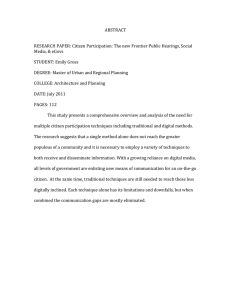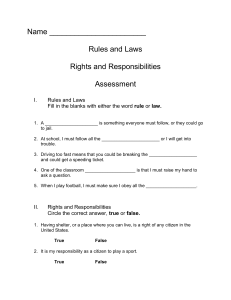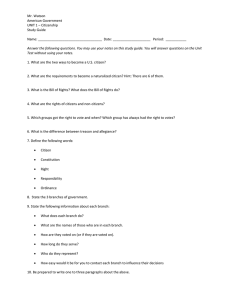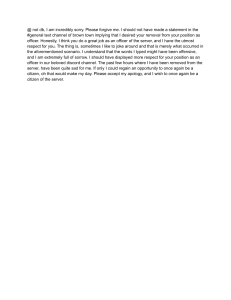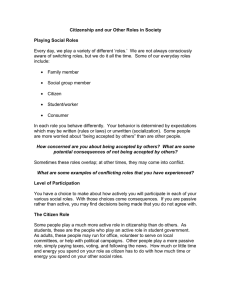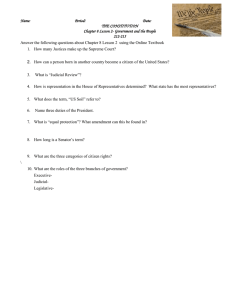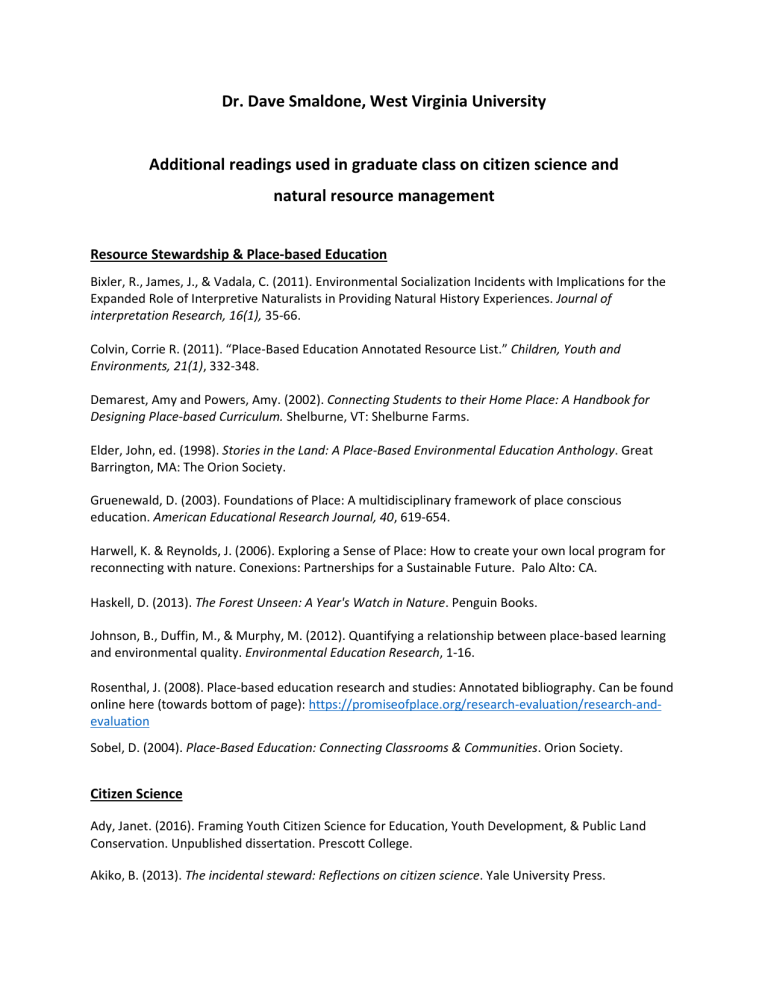
Dr. Dave Smaldone, West Virginia University Additional readings used in graduate class on citizen science and natural resource management Resource Stewardship & Place-based Education Bixler, R., James, J., & Vadala, C. (2011). Environmental Socialization Incidents with Implications for the Expanded Role of Interpretive Naturalists in Providing Natural History Experiences. Journal of interpretation Research, 16(1), 35-66. Colvin, Corrie R. (2011). “Place-Based Education Annotated Resource List.” Children, Youth and Environments, 21(1), 332-348. Demarest, Amy and Powers, Amy. (2002). Connecting Students to their Home Place: A Handbook for Designing Place-based Curriculum. Shelburne, VT: Shelburne Farms. Elder, John, ed. (1998). Stories in the Land: A Place-Based Environmental Education Anthology. Great Barrington, MA: The Orion Society. Gruenewald, D. (2003). Foundations of Place: A multidisciplinary framework of place conscious education. American Educational Research Journal, 40, 619-654. Harwell, K. & Reynolds, J. (2006). Exploring a Sense of Place: How to create your own local program for reconnecting with nature. Conexions: Partnerships for a Sustainable Future. Palo Alto: CA. Haskell, D. (2013). The Forest Unseen: A Year's Watch in Nature. Penguin Books. Johnson, B., Duffin, M., & Murphy, M. (2012). Quantifying a relationship between place-based learning and environmental quality. Environmental Education Research, 1-16. Rosenthal, J. (2008). Place-based education research and studies: Annotated bibliography. Can be found online here (towards bottom of page): https://promiseofplace.org/research-evaluation/research-andevaluation Sobel, D. (2004). Place-Based Education: Connecting Classrooms & Communities. Orion Society. Citizen Science Ady, Janet. (2016). Framing Youth Citizen Science for Education, Youth Development, & Public Land Conservation. Unpublished dissertation. Prescott College. Akiko, B. (2013). The incidental steward: Reflections on citizen science. Yale University Press. Briggs, L. (2013). Conservation in cities: Linking CS & Civic Ecology Practices. Report. 1-13. Conrad, C., & Hilchey, K. (2011). A review of citizen science and community-based environmental monitoring: issues & opportunities. Environmental Monitoring & Assessment, 176: 273-291. Devictor, V., Whittaker, R., & Beltrame, C. (2010). Beyond scarcity: Citizen Science programmes as useful tools for conservation biogeography. Diversity and Distributions. 16: 354-362. Dickinson, E. & Booney, R. (Eds.). (2012). Citizen Science: Public Participation in Environmental Research. Ithaca: Cornell University Press. Key Chapters: 1, 2, 5, & 14. Haywood, B. (2014). Birds and Beaches: The Affective Geographies and Sense of Place of Participants in the Coast Citizen Science Program. Unpublished Dissertation. University of South Carolina. Jones, M. The Conservation Volunteers. (2013). The impact of citizen science activities on participant behaviour & attitude. Project Report. McCallie, E., Bell, L., Lohwater, T., Falk, J. H., Lehr, J. L., Lewenstein, B. V., Needham, C., and Wiehe, B. (2009). Many Experts, Many Audiences: Public Engagement with Science and Informal Science Education. A CAISE Inquiry Group Report. Washington, D.C.: Center for Advancement of Informal Science Education (CAISE). http://caise.insci.org/uploads/docs/public_engagement_with_science.pdf Phillips TB, Ballard HL, Lewenstein BV, Bonney R. (2019). Engagement in science through citizen science: Moving beyond data collection. Science Education. 1–26. https://doi.org/10.1002/sce.21501. Price, C. & Lee, H-S. (2013). Changes in Participants’ Scientific Attitudes and Epistemological Beliefs During an Astronomical Citizen Science Project. Journal of Research in Science Teaching, 50(7), 773-801. Tools of Engagement: A Toolkit for Engaging People in Conservation. (2011). National Audubon Society. EETAP, USFWS & TogetherGreen. Available at http://web4.audubon.org/educate/toolkit/ Trautmann, N. M. (Ed.). (2013). Citizen Science: 15 Lessons that Bring Biology to Life, 6-12. NSTA Press. Tweddle, J.C., Robinson, L.D., Pocock, M.J.O. & Roy, H.E (2012). Guide to citizen science: developing, implementing and evaluating citizen science to study biodiversity and the environment in the UK. Natural History Museum and NERC Centre for Ecology & Hydrology for UK-EOF. Available online: www.ukeof.org.uk US Department of Interior Service-learning Toolkit. (2014). Innovations in Civic Participation. Wiggins, A., et al. (2013). Data Management Guide for Public Participation in Scientific Research. DataONE Public Participation in Scientific Research Working Group. Lost Ladybug Project—Summative Evaluation Report (2012). Prepared by Jessica Sickler. Institute for Learning Innovation. Environmental Protection Belongs to the Public: A Vision for Citizen Science at the EPA. (2016). White paper by the NACEPT. Informal Science & Persuasive Communication: Cooney, N. (2011). Change of Heart: What Psychology Can Teach Us About Spreading Social Change. NY: Lantern Books. Ham, S. (2013). Interpretation: Making a Difference on Purpose. Golden, CO: Fulcrum Publishing. Heimlich, J. & Ardoin, N. (2008). Understanding behavior to understand behavior change. Environmental Education Research, 14(3), 215-237. http://lewenstein.comm.cornell.edu/science-communication-resources/

